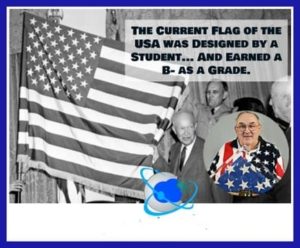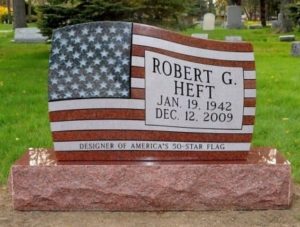Fact of the Day-Our 50 Star Flag(with a bonus)
I feel compelled to put something up on this date every year regarding this. I didn’t know the guy or the teacher, except by name, and I liked the story. I’ve lived in Lancaster for over 38 years, so I can claim this one, although my heart remains in a little town called Mantua in northern Ohio. We moved to November 2022.
Anyway, it’s an interesting story from when schools expected more from students. First, an Ohio high school student designed the 50-star American flag for a class project. Then, the kid goes a step further and designs a 51-star American flag as extra credit.
We’re talking about a 17-year-old Lancaster High student, Robert G. Heft, in 1958, as a school project designed the 50-star American flag. Originally Heft received a B– for the project, even with what I consider extra credit.
project designed the 50-star American flag. Originally Heft received a B– for the project, even with what I consider extra credit.
After discussing the grade with his teacher, they agreed (somewhat jokingly) that if Congress accepted the flag, the grade would be reconsidered. One strict teacher when it comes to handing out grades.
Well, Heft’s flag design was chosen and adopted by presidential proclamation. I guess Ike liked it, so his campaign slogan was “I Like Ike!” Not really, but I had to throw it in even though it makes no sense here.
According to Heft, his teacher changed his grade to an A for the project. The teacher was Stanley Pratt. As an aside, Heft’s mother was a seamstress. You may think he cheated, but she didn’t help since it was his project. Back then, parents didn’t do the homework for their kids. I’ve read Heft  sewed the final flag together in 12 1/2 hours. As I said, he also designed a 51-star flag—a fascinating picture of his gravestone.
sewed the final flag together in 12 1/2 hours. As I said, he also designed a 51-star flag—a fascinating picture of his gravestone.
Another aside, but you can stop reading here. The B- to A grade thing just hit me. In sixth grade, I received an ‘F’ in handwriting. I had a teacher who wasn’t content to give an ‘F’ though; she had to do it in red ink. Toward the end of the year, a handwriting sample of all students was sent to the Ohio Department of Education.
Guess what? My writing that earned an ‘F’ received one of only four Superior Awards for our school. My picture was even in the newspaper with the other kids wearing my short jeans and tennis shoes. But, my grade on my report card went from F to A, maybe A+, during the final grading period. I can’t remember now, but I hope it was a different color ink. It is a colorful report card, though. I should post it someday.



